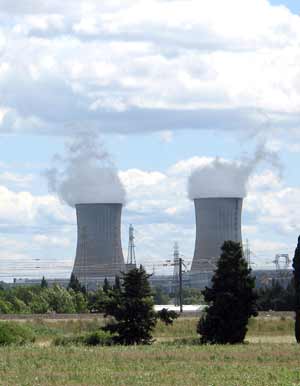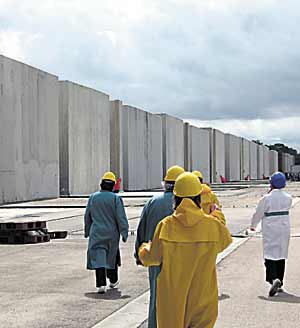La republique nucleaire
The Press | Saturday, 4 August 2007
POWERING A NATION: the cooling towers at the Tricastin nuclear power station rise in the south of France.

BUILT TO LAST: concrete bunkers at Andra's radioactive-waste dump at Aube, in the Champagne region.
To talk about going nuclear in New Zealand might be bordering on treason, but in France it is the source of most of their power and no small amount of pride. PAUL GORMAN reports.
Nuclear power is as French as croissants, red wine and reckless driving.
For someone from a non-nuclear nation, it takes a while to get your head around the fact that almost 80 per cent of electricity coming through French power points comes from a nuclear power station, making it proportionately the most nuclear-powered country in the world.
France has 58 nuclear reactors at 19 sites around the country, all operated by the state-owned giant, Electricite de France (EDF). Their total generating capacity is more than 63,000 megawatts (MW) of electricity and between them they supply more than 425 billion kilowatt hours (kWh) a year, about 70 billion kWh of which is exported to other European countries.
Compared with New Zealand power stations, French nuclear plants are gigantic. Our largest power station is Genesis Energy's 1000MW coal and gas-fired steam plant at Huntly, but even the smallest French nuclear plants generate 1800MW. The largest French plant, at Gravelines, near Calais on the English Channel coast, produces 5400MW of power, more than New Zealand needs on an average-to-high-demand day.
So the French have no lack of electricity, no real worries about rising power demand and no annual power crises. You can leave a couple of lights burning on a cold night and not worry about blowing up the national grid.
On the whole, the French are proud of their nuclear power, or have at least learned to accept it. From time to time there are protests against new nuclear power stations or radioactive-waste sites, but even Greenpeace activists in Paris say that if they were in charge they would stick with nuclear power until the current plants are due for decommissioning between 2020 and 2030.
The French Government decided to follow the nuclear path in 1974, just after the first oil shock. Until then it had generated most of its power by burning oil, due to a lack of indigenous energy sources, but that was obviously unsustainable in the wake of soaring oil prices. By the late 1980s more than 50 nuclear plants had been commissioned.
Cultural factors are also partly responsible for nuclear power's popularity. The French appear to have high regard for scientists and engineers, they like big projects, and the fact that nuclear facilities are government-run adds to the sense of security.
French eyebrows rise when I say it is almost treasonable in New Zealand to even suggest having a public debate on nuclear power.
But New Zealand's Labour Government has made it absolutely clear that, as long as it is in power, no consideration will be given to nuclear power. In the Government's draft national energy strategy, Energy Minister David Parker says design advances may have improved the safety of nuclear plants, but nuclear power is still more expensive than other forms of generation and serious concerns remain about the consequences of accidents or terrorist attacks, the disposal of radioactive waste and the use of nuclear materials in weapons.
The nuclear issue has gained a small amount of traction recently as New Zealanders' demand for power continues to rise and as Kiwis continue to oppose potential new hydro and wind-power projects and burning coal to generate electricity. We got within a uranium pellet's-width of a discussion late last year when the Royal Society of New Zealand considered promoting a public debate on the subject, but chose instead to back a discussion on clean-burning coals.
Compare that with Australia, where Prime Minister John Howard called for a report on the feasibility of nuclear power stations, which found they would be economically viable if a carbon tax could be introduced to make nuclear power more competitive with the country's greenhouse-gas-belching, brown-coal power stations.
The report concluded that 25 nuclear power stations could be built by 2050 to generate about one-third of the country's electricity. The likely location of nuclear plants near population centres on the coast has concerned environmentalists and opposition groups.
Any nuclear-power developments across the Tasman will affect us. Whether we like it or not, we are downwind of New South Wales and Victoria.
Howard's sudden push for nuclear power is not all that surprising, given his country has the world's largest uranium reserves and that in the five years to mid-2006 it exported 47,500 tonnes of uranium-oxide concentrate, with a value of more than $A2 billion, purely for generating nuclear power.
Nuclear power stations dot the pretty French countryside, popping up like mushrooms with their steaming cooling-towers and bland concrete structures among fields of waving sunflowers and brilliant lavender.
Our tour took us – two Kiwi and two Australian journalists – to the international experimental nuclear fusion project ITER, EDF's 3600MW nuclear power station at Tricastin, in the south of France, and to the Aube waste-disposal centre in the east of France.
We were welcomed at each site, but it was clear there was more interest in Australia than in New Zealand. Our hosts wanted to know how the Australian debate was going, and even took the opportunity to promote French expertise in nuclear technology. But there was little interest in New Zealand. Perhaps they gave up on us long ago because of our anti-nuclear stance, our size and lingering sentiments from the bombing of the Rainbow Warrior.
The lack of a New Zealand flag at the Aube nuclear-waste disposal centre, nestled in the cool oak forests of eastern France, said it all. There, flapping proudly next to the French Tricolour, was the Australian flag.
Our Australian colleagues were amused and keen to point it out to the national radioactive-waste management agency, Andra. We were happy to keep quiet.
Andra's international-affairs director, Dr Gerald Ouzounian, apologised and said we were the first New Zealanders to set foot in the centre, in the heart of France's Champagne region. He said he would get a New Zealand flag for the next Kiwi visitors.
In a strange way I felt pleased our flag was missing from a site where one million cubic metres of radioactive waste will be dumped in the next half century, requiring close monitoring for at least 300 years.
Proverville newspaper journalist Willy Billiard was brought in to talk to us.
"There's still a hard core of anti-nuclear people, but Andra are very open, (and) work hard to educate the local people about what they are doing," Billiard said.
Local residents were comfortable with the country's nuclear programme, he said.
"We all love this country. We are not wanting anything that will harm that."
Our hosts had answers to the tricky questions but were selective with their replies.
At the Tricastin power station, we heard about the eight-step nuclear-accident scale for reporting the seriousness of incidents or accidents, where step zero is a "small gap in procedure" and step seven is a "major accident" equivalent to a Chernobyl meltdown.
They told us that last year there had been 36 events at the zero level and two level-one anomalies that were "not important at all". A level-two incident was recorded in the 1990s.
But they didn't mention that they distribute iodine tablets to residents of villages within 10km, with instructions to follow in case of a nuclear accident, specifying how to take shelter and to take iodine, and outlining evacuation procedures.
We were also told that in the event of an accident it would take only two seconds to shut down the reactor, but not what might happen in those seconds.
Asked about the dangers of working so close to nuclear reactors, we were told we'd been exposed to more radiation flying to France than an average power-plant worker would receive in a year; that there was more risk from granite, old smoke detectors and luminous clocks.
Put up the argument that the threat from earthquakes means it would be unwise to build nuclear reactors in New Zealand and you get the assurance they are built to withstand major shaking – this just a couple of weeks before a radiation leak from the world's biggest nuclear plant, in Japan, after a 6.8 magnitude earthquake.
Express concern about radioactive waste and they say at least they know where it is, which must surely be better than discharging waste from burning coal into the atmosphere.
Sustainable-energy guru Ralph Sims could be the catalyst for a nuclear-power debate here.
Sims, director of Massey University's Centre for Energy Research and now seconded to the renewable-energy unit at the International Energy Agency in Paris, admits to undergoing something of a conversion on the matter, having been in the Values Party in his youth.
He says working on the Intergovernmental Panel on Climate Change has reinforced two things – the regard in which New Zealand is held in environmental and climate-change circles, and the key role nuclear energy will play in reducing greenhouse-gas emissions.
"Everybody wants electricity, but nobody wants power stations, wherever they are. My view now is that the latest nuclear technologies are nowhere near as bad as the ones we tend to think about with nuclear. There's still risk, but how many have died from nuclear power plants, other than Chernobyl? In China, 5000 people die a year digging coal out of the ground.
"So I've kind of reviewed my thinking about nuclear. In New Zealand it wouldn't work at this time. Commercial-scale nuclear plants are 1000 to 1500MW – that's one big chunk of New Zealand's electricity demand. It would take 20 years to get the infrastructure in place, (and) waste treatment, never mind getting through the resource-consent process."
Sims says the French are well aware of New Zealand's attitude to things nuclear.
"People realise it doesn't match the New Zealand scene. There's no criticism of New Zealand as being anti-nuclear. I think some people are envious in some ways. What is quite surprising for them is, if you ask any New Zealander walking down the street about nuclear, there's such an opposition."
The Canterbury Manufacturers Association's chief executive, John Walley, envisages a future where a joint New Zealand-Australia venture could supply electricity needs on both sides of the Tasman through five large nuclear reactors, one in New Zealand.
The co-operative approach could extend to providing training, monitoring and safety procedures, and the reprocessing and disposal of waste.
"We have got to move away from this idea that we are nuclear-free. Most of our hospitals have significant nuclear sources that are used in medicine. The idea there is no ionising radiation in New Zealand is a green delusion," Walley says.
"Whether or not we can build a nuclear industry, we have to think hard about co-operation with the Australians. The reality is, nuclear is going to play a significant role in a low-carbon future. I don't think we need to worry about nuclear reactors for 20 to 25 years but at that point I think we might need it.
"But the point is, don't make the issue a sacred cow – it needs to be put on the table."
Safety and waste are always going to be concerns, Walley says.
"The new-generation nuclear plants coming though are intrinsically safe. The trouble is, everyone thinks of Chernobyl, Three Mile Island and two-headed fish."
* Paul Gorman travelled to France as a guest of the French Ministry of Foreign Affairs.
© Fairfax New Zealand Limited 2007. To subscribe or visit go to: http://www.stuff.co.nz/